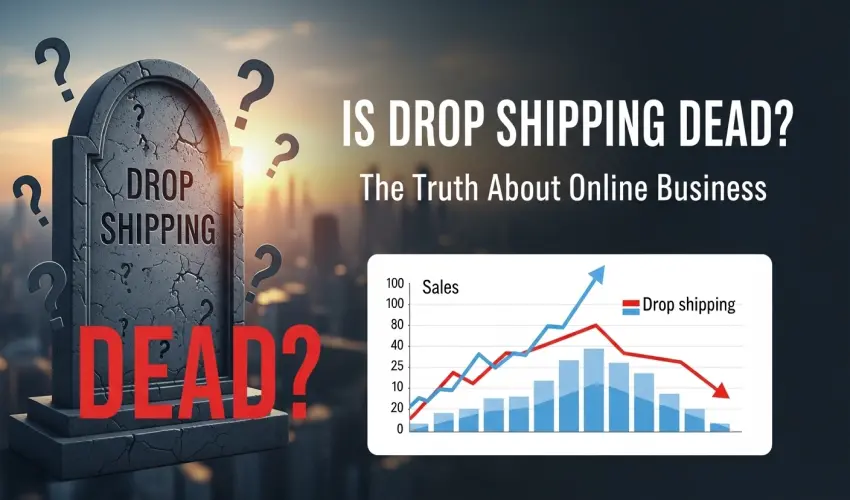Is Dropshipping Dead? The Truth About Online Business
Published Aug 10, 2025
1 0
Key Takeaways
-
Dropshipping is not dead, but it is much harder than it was during its early boom years.
-
Increased competition, higher ad costs, and consumer skepticism have made success more challenging.
-
Unique branding, high-quality suppliers, and excellent customer service are now critical for standing out.
-
Platforms like Shopify, Amazon, and TikTok offer opportunities but require smarter strategies.
-
Relying solely on trending products no longer works; building a real brand is essential.
-
Dropshipping is evolving, not dying. It rewards those who treat it like a real business, not a get-rich-quick scheme.
Introduction
Dropshipping was once hailed as the golden ticket to easy online wealth. Low startup costs, no inventory, and minimal risk—what's not to love? Influencers and success stories painted dropshipping as a dream side hustle anyone could start from their laptop.
Fast forward to 2025, and you’ll hear a different story: “Dropshipping is dead.”
But is it really? Or has the game simply changed? In this article, we’ll explore the real state of dropshipping today, the myths versus the reality, and what it takes to succeed in the new landscape of online business.
1. The Rise of Dropshipping: A Quick Recap
Dropshipping exploded in popularity around 2016-2019, driven by:
-
Platforms like Shopify making store creation incredibly easy.
-
Facebook Ads offering cheap, targeted marketing.
-
Access to global suppliers via AliExpress and other platforms.
-
The fantasy of "passive income" with little effort.
Thousands jumped in, flooding the market with similar stores selling the same products. Early adopters who understood digital marketing made fortunes. But like any gold rush, saturation followed.
2. Why People Say "Dropshipping Is Dead"
a) Oversaturation
When every third person launches a store selling the same trending gadgets, competition becomes brutal. Product margins shrink, and customer acquisition costs soar.
b) Rising Ad Costs
Facebook, Instagram, and TikTok ads have become much more expensive. Acquiring a customer today often costs more than the profit made on a single sale, unless you have a strong brand or upselling system.
c) Consumer Skepticism
Shoppers have become wary. Low-quality products, long shipping delays from overseas, and poor customer service have created widespread mistrust. People now think twice before buying from an unknown online store.
d) Platform Crackdowns
Amazon, eBay, and Facebook have tightened their rules on dropshippers, requiring faster shipping times, authentic products, and better customer experiences.
3. The Evolution of Dropshipping: It's a Real Business Now
Despite these challenges, dropshipping isn’t dead; it has evolved. Successful entrepreneurs today are doing it differently:
-
Branding: Creating strong, recognizable brands instead of faceless, generic stores.
-
Quality Control: Vetting suppliers carefully to ensure good product quality and faster shipping.
-
Niche Focus: Targeting specific communities or interests rather than chasing general trends.
-
Customer Experience: Offering fast responses, easy returns, and personalized service.
Those who treat dropshipping like a real business are still thriving.
4. New Challenges Facing Modern Dropshippers
a) Logistics and Shipping Expectations
Amazon Prime has spoiled consumers. They expect 2-day shipping and easy returns—standards that traditional AliExpress dropshipping can't meet. New dropshippers must now explore U.S.-based suppliers or warehousing options.
b) Building Trust
Without a trusted brand, it’s nearly impossible to scale. Trust signals like professional website design, verified customer reviews, and transparent policies are crucial to converting wary shoppers.
c) Rising Competition From Big Brands
Even small niches now attract established brands. Competing purely on price is a losing game. A unique value proposition and strong storytelling are essential.
5. Opportunities That Still Exist
Despite the obstacles, dropshipping still offers real opportunities for the savvy entrepreneur:
-
Micro-Niches: Instead of selling “pet supplies,” sell "eco-friendly hiking gear for dogs." Hyper-specific targeting leads to passionate customer bases.
-
Product Innovation: Find unique products (customized, bundled, or upgraded versions of bestsellers) to gain an edge.
-
TikTok and Influencer Marketing: Organic TikTok videos or influencer shoutouts can offer cheaper customer acquisition than traditional ads.
-
Subscription Models: Offering subscription boxes or memberships can create stable, recurring revenue.
6. The New Skillset for Success
Today’s successful dropshipper is no longer just someone who can run Facebook Ads. They are:
-
Brand Builders: Understanding storytelling, design, and customer psychology.
-
Data Analysts: Constantly tracking metrics like ROAS (Return on Ad Spend) and CAC (Customer Acquisition Cost).
-
Customer Experience Managers: Ensuring satisfaction post-sale to drive repeat business and positive reviews.
-
Trend Spotters: Moving quickly on emerging products and cultural shifts.
Conclusion
Dropshipping isn’t dead, but the era of easy money is over. It’s no longer enough to throw up a basic Shopify store, copy a trending product from AliExpress, and run a few ads. The new reality demands a deep commitment to branding, product quality, customer trust, and marketing innovation.
The people shouting “dropshipping is dead” are often those who treated it like a get-rich-quick scheme. Those who treat it like a real business, invest in their skills, and build something customers love can still find incredible success. The bar is much higher, but the opportunities for smart, hardworking entrepreneurs are still very much alive.








